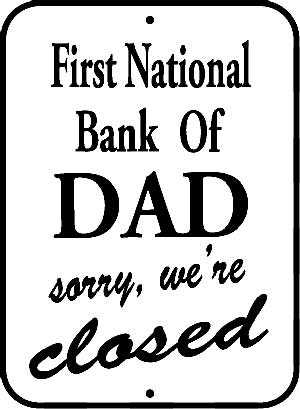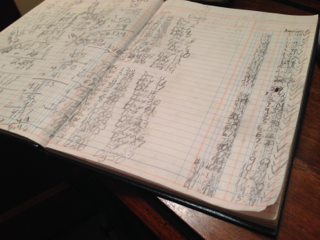Morning News Rant
Do you find yourself eating your morning granola, hunched over the financial news, stopping in the middle of a paragraph, feeling your eyes glaze over as your BS-meter tilts red in 0.6 seconds, and then looking up at the window to start mumbling like a deranged person to yourself about the absurdity of that business story?

You do?
What a coincidence, because so do I! That’s so weird! It’s like we’re twins!
Well, ok, not so weird, because you read Bankers Anonymous and you understand that’s one of our conditions – the daily, and perhaps hourly frustration with the Financial Infotainment Industrial Complex’s faulty depiction of events that affect our lives.
Why do I bring up our common condition today?
I’ll tell you why.

I live in South Texas, where the development of fracking fields is in the process of revolutionizing energy production in the US. I believe the consequences of this process, for everything from renewable energy, to regional job creation, to potential environment liability, to geopolitical and Middle Eastern politics cannot be exaggerated.
As a result, I read what I can about business developments in my regional back yard, both in the local paper – The San Antonio Express News – and the Wall Street Journal.
The local paper’s coverage has its flaws[1], but I want to pick a fight with a story today in the Wall Street Journal. I have found that of the two papers, only the Wall Street Journal covers the Eagle Ford Shale stories from the perspective of national and international public and private equity firms, and I appreciate this, since it’s missing from my local paper.
I should also say my following rant pertains not particularly to the oil and gas or fracking industry, but rather practically any industry covered by the Financial Infotainment Industrial Complex.
The part of the story where my BS-meter hit red
The WSJ story describes the sale of Texas shale-driller GeoSouthern Energy Corp to Devon Energy Corp for $6 Billion, the largest acquisition of the year in the US in the oil and gas industry. (Pretty important news, which at least 24 hours after the announcement, the local paper still hasn’t touched. But I digress.)
What gets my goat is a quote buried in the middle of the story by “Wells Fargo energy analyst” David Tameron. Tameron says:
If you are private[2] right now and you can sell yourself, you do. If I’m a buyer and there are a lot of people who want out the door, it’s a good time to be buying.
Maybe this quote was taken out of context, and if so, I apologize to David Tameron, Wells Fargo energy analyst, for what I’m about to say.
My interpretation of Tameron
I interpret Tameron’s statement as:
“If you’re selling an oil drilling company, it’s a good time to do that. Also, if you’re buying an oil drilling company, it’s a good time to do that.”
This is an absurd ‘analysis,’ by David Tameron, Wells Fargo Energy Analyst.
Tameron’s statement goes unchallenged by the Wall Street Journal as the self-serving, churn-inducing statement that it really is.
In the real investing world – not currently occupied by either David Tameron, Wells Fargo Energy Analyst, or the Wall Street Journal reporter on this story – there are attractive times to invest $6 Billion in an oil and gas drilling company, and there are less attractive times.
Most of the time, for real investors, we can not be sure whether it’s an attractive time, or not, to be making a $6 Billion investment in an oil and gas drilling company. Because it really depends on a lot of unknowable future factors, not least of which are the future input costs and output costs for oil and gas, both of which are volatile.
Some time in the future, we may eventually know whether it was a good time to be a buyer of GeoSouthern Energy Corp for $6 Billion, or not. The answer may even change a few times in the future, again, because markets fluctuate.
From an investor’s perspective
What I do know, however, is that it’s not simultaneously a good time to buy and a good time to sell.
Wait, I need to be more specific. For investors in the transaction, it is not simultaneously both a good time to buy and a good time to sell. From an investor’s perspective, it will end up being a good time for one side, and a bad time for another side, some time in the future.
From the brokers’ and the Financial Infotainment Industrial Complex’s perspective
But the investor’s perspective is not shared by brokers or the Financial Infotainment Industrial Complex.
For financial intermediaries (brokers) who buy and sell companies – or stocks, or bonds, or currencies, or real estate – its always simultaneously a good time to buy and sell the same thing, since this is how they make money.
And for members of the Financial Infotainment Industrial Complex, of which the Wall Street Journal is among the most important and sophisticated, it’s always simultaneously a good time to buy and to sell. Because transactions create events, which in turn gives them something for them to talk about. They are not investors but rather cheerleaders.
This Eagle Ford Shale example this morning – like the several or dozens of financial transactions a day we vaguely witness passing through the peripheral transom of our financial mindshare – just reminded me of the different incentives we have when compared to the united front of brokers and the Financial Infotainment Industrial Complex.
The Financial Infotainment Industrial Complex needs to churn a story every day, that’s how they get revenue.
And brokers – represented in this example by David Tameran, Wells Fargo energy analyst – need to try to churn a transaction every day.
As consumers (victims?) of the Financial Infotainment Industrial Complex we get hit with somebody else’s strong bias – the need to constantly churn transactions.
The truth that this does not help us think straight about investing – in fact it undermines our ability to think about investing – is rarely mentioned.
You and me, I guess we know this. We are, somewhat, occasionally, immune. But what about the rest of the folks out there, fed the disturbingly wrong, the self-servingly biased line, that it’s always simultaneously a good time to be buying and selling?
Sigh. Time to finish my granola.
[1] Fine, since you asked, what’s wrong with the local paper? The local paper only covers the Eagle Ford Shale with three themes. A) Fracking = Lots of Jobs! B) We need to invest in the roads in south Texas that are being hurt by super-heavy truck traffic! C) There are plucky wild-catters trying to make money here. Of these, stories A and B are true as they go, and C is absolutely, totally, and completely misleading, since wildcatters comprise approximately 0.0001% of the activity in the Eagle Ford. As far as the other potential stories of the Eagle Ford, the local paper does not cover them. These might include: a) Environmental impacts b) The national and international businesses doing deals in South Texas, and their relationship to high-profile public and private equity firms c) Technological innovation in the fracking process in the past 10 years and d) the revolutionary impact of 90 years’ worth of affordable energy on our lives as well as on the renewable energy business.
[2] “private” in this sense meaning the fact that GeoSouthern Energy Corp is owned privately, it has no public shares outstanding.
Post read (4065) times.


